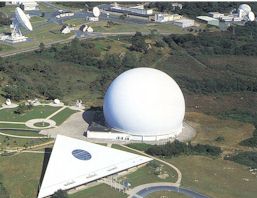Milestones:First Transatlantic Reception of a Television Signal via Satellite, 1962
First Transatlantic Reception of a Television Signal via Satellite, 1962
On 11 July 1962 this site received the first transatlantic transmission of a TV signal from a twin station in Andover, Maine, USA via the TELSTAR satellite. The success of TELSTAR and the earth stations, the first built for active satellite communications, illustrated the potential of a future world-wide satellite system to provide communications between continents.
Research into ways of improving the quality and quantity of intercontinental telephone lines has been an ongoing focus for a number of years. One of the first underwater telephone cables, laid between France and the United States in 1956, provided an extremely limited capacity of only 36 channels. The transmission of televised programming was non-existent. Programs were recorded manually on a magnetic tape, and ten dispatched by airplane courier to its destination studio, where is would be "replayed" in order to disseminate its contents to spectators.
In April 1961 a multi-national agreements was signed between the American Telephone and Telegraph Company (AT&T), Bell Telephone Laboratories (Bell Labs), NASA, the British Post Office, and the French National PPT (Post Office.) This agreement established a joint collaboration for the project development of two active, mobile telecommunications satellites, "TELSTAR" and "Relay."
The Pleumeur-Bodou, France site was selected for installation of the telecommunications centre for a variety of reasons:
- its proximity to the CNET laboratories
- the absence of radio interference, and the national protection provided by the surrounding foothills, which would protect the site from future radio interference'
- its geographical position on the western coast of France which offered optimal conditions for common satellite visibility, similar to that of the USA
- its mild climate
The first Radome was only temporary, and was installed in order to house the construction site for the antenna. Both this temporary shelter and the final Radome measured 64 meters in diameter. The final Radome, installed in France in the summer of 1962, is now a museum. It is made of Hypalon coated Dacron and weighs over 30 tons.
TELSTAR I was launched from Cape Canaveral (now the Kennedy Space Center) on 10 July 1962. TELSTAR I was placed in an elliptical orbit (completed once every 2 hours and 37 minutes), rotating at a 45 degree angle above the Earth's equator. The maximum transmission time between Europe and the United States was 20 minutes per pass. On 11 July 1962 the TELSTAR Satellite transmission was received in Pleumeur-Bodou, enabling the world's first satellite transmission of a short television program from the United States.
This was part of a triple dedication honoring TELSTAR on& 11 July 2002. The other two Milestones are:
First Transatlantic Television Signal via Satellite, 1962
Goonhilly Downs, Cornwall, England - July 2002 - IEEE UKRI Section
First Transatlantic Transmission of a Television Signal via Satellite, 1962
Andover, Maine - July 2002 - IEEE Maine Section
Map
